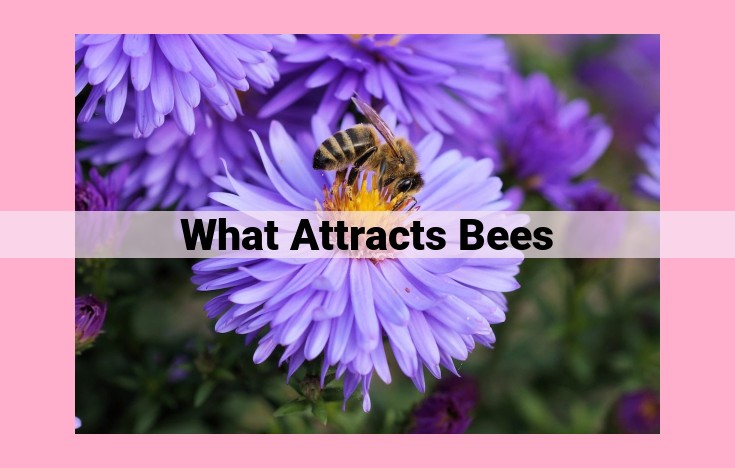Factors Attracting Bees: Essential Elements, Mutualism, And Habitats

Bees are drawn to certain elements that are essential for their survival. These include flowers that provide nectar and pollen as food sources, water sources, and hives or colonies that offer shelter and protection. Bees also engage in mutualistic interactions, such as pollination, which benefits both plants and bees. Additionally, forage, aromatic crops, and suitable habitats play a crucial role in attracting bees.
Essential Elements for Bee Survival
- Importance of flowers, providing nectar and pollen as food sources.
- Significance of water and the availability of clean water sources.
- Role of hives and colonies in providing shelter and protection.
Essential Elements for Bee Survival
For bees to thrive, certain elements are absolutely crucial. Let’s delve into the three most vital components:
Nourishing Sustenance: Flowers, Nectar, and Pollen
Bees, like humans, need a constant supply of food. Flowers play an indispensable role in their diet, providing both nectar, a sugary liquid rich in energy, and pollen, a protein-packed powder that nourishes their young. Without access to these floral treasures, bees would struggle to survive.
Life-Sustaining Water: A Matter of Hydration
Just like any other living creature, bees require water to stay hydrated and healthy. It is essential for regulating body temperature, transporting nutrients, and facilitating digestion. Clean water sources, free from pesticides and other contaminants, are vital for the well-being of bees.
Shelter and Protection: The Hive’s Embrace
Bees are social insects, living in hives or colonies for protection and support. The hive provides a safe haven from predators and harsh weather, ensuring the survival of the entire colony. Within the hive, individual bees work together to build hexagonal cells, which serve as storage for honey and a secure environment for developing larvae.
Mutualistic Interactions: The Symphony of Nature’s Interdependence
In the tapestry of life, mutualistic interactions are intricate threads that bind species together in a dance of reciprocal benefits. Among these remarkable partnerships, the relationship between bees and plants stands as a shining example of co-evolution and mutual reliance.
The Pollination Process: A Blossoming Harmony
This dance begins with the humble flower, offering its nectar and pollen, the lifeblood of bees. As bees flit from bloom to bloom in search of sustenance, they inadvertently become ambassadors of pollination. Their tiny bodies, dusted with pollen, carry the genetic material necessary for plant reproduction.
This exchange is a win-win situation. Plants receive the essential aid of pollination, ensuring the continuation of their species. Bees, in turn, reap the nutritional rewards of nectar and pollen, providing sustenance and energy for their colony’s survival.
Beneficial Insects: Nature’s Unseen Guardians
The realm of mutualistic interactions extends beyond the realm of bees and plants. Beneficial insects, such as ladybugs and lacewings, play crucial roles in controlling pests and pollinating plants. By preying on aphids and other destructive insects, these tiny protectors safeguard agricultural crops and maintain the balance of ecosystems.
In this intricate web of relationships, each species plays a vital part in the harmony of nature. Bees, plants, and beneficial insects form an unbreakable bond, ensuring the continued flourishing of our planet’s biodiversity. By understanding and appreciating these mutualistic interactions, we can become more mindful stewards of our shared environment.
Understanding the Essential Supporting Factors for Bee Survival
The Concept of Forage: A Vital Nutrient Source
Forage, a term referring to the various plant materials consumed by bees, plays a crucial role in their survival and overall health. It primarily consists of nectar, a sugary liquid rich in carbohydrates, and pollen, a nitrogen-rich protein source vital for the development and growth of bees. Bees diligently collect nectar and pollen from flowers and utilize these resources to sustain the hive and rear their young. Access to ample and diverse forage is paramount for the well-being and productivity of bee colonies.
The Allure of Aromatic Crops: Attracting Pollinators
Strategic planting of aromatic crops can serve as a magnet for bees. These crops, characterized by their strong and distinct scents, possess a remarkable ability to attract and entice bees. The underlying mechanism lies within the sensitivity of bees’ antennae to volatile organic compounds emitted by certain plants. By incorporating aromatic crops into their surroundings, such as lavender, thyme, or rosemary, gardeners can create a haven for bees, promoting the establishment and thriving of these vital pollinators.
Nesting Sites and Protection: A Safe Haven for Bees
Suitable habitats that provide nesting sites and protection are indispensable for bee survival. Bees require designated spaces within cavities or structures to establish their hives and raise their young. Natural nesting sites include hollow trees, rock crevices, and abandoned rodent burrows. However, as urbanization and habitat loss continue to threaten bees, it is crucial for humans to take proactive measures to provide alternative nesting options. Beekeepers and conservationists can install beehives or construct nesting boxes in sheltered locations, ensuring the safety and well-being of these pollinating insects.